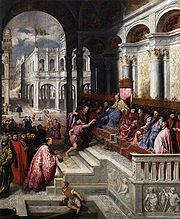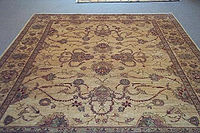
Ushak Carpet
Encyclopedia
Uşak carpets, Ushak carpets or Oushak Carpets are Turkish carpet
s that use a particular family of designs, called by convention after the city of Uşak
, Turkey
– one of the larger towns in Western Anatolia
, which was a major center of rug production from the early days of the Ottoman Empire
, into the early 20th century (although these patterns were woven in other regions also).
The level of international popularity attained by Uşak's carpets became such that the word "Ushak" is considered an English word of Turkic origin
an markets, the earlier types of Turkish carpets, before the "star" type, are now often called "Lotto carpet
s" and "Holbein carpet
s". The terms make reference to their depiction in minute detail in paintings by Lorenzo Lotto
and Hans Holbein the Younger
, in which they are often placed in a way to brighten the background, and suggest status. The region of Uşak still remains a vibrant center of hand-made carpet weaving today.

, Savonnerie and Axminster
. The wane in the European market meant that Oushak production declined. Those that were still made throughout the late 18th and early 19th centuries were manufactured for upper class people in the Turkish territories on Eastern Europe.2
Towards the end of the 19th century, when the European market began to be interested in Persian carpets once again, the Ushak (Oushak) population did not have enough weavers still skilled in the traditional Oushak craft
. Manufactories
had to turn to neighboring villages and their craftsmen who still maintained traditional techniques.3
Ushak carpets, particularly those known as Lotto carpet
s, are among the later types of Oriental carpets in Renaissance painting
, as they were imported by Europeans, where they adorned cathedral
s, churches, and the homes of the wealthy and powerful.
and medal
lion carpets originated in Oushak.4
Oushak rugs are known for the silky, luminous wool they work with. The dyes tend towards: cinnamons, terracotta tints, gold, blues, greens, ivory, saffron and grays.5
The late 19th century saw the rejuvenation of Oriental rug production, at this time Oushak re-surfaced as a preeminent center of weaving industry. The new Oushak industry saw two major shifts in design: floral patterns in the Persian tradition were incorporated in to design and room size, decorative carpets were woven as European standards demanded.6
The late 19th century weavers came from villages outside of Oushak and employed tribal techniques. Paramount to these techniques was the use of larger knots (sometimes less than 30 knots per square inch) and an all-wool foundation.7 The tribal style fused with the older Ushak/Smyra designs. The merger of the two styles created a new style simply known as late 19th/early 20th century Oushak carpets.8 The new decorative Oushak, commercially woven, employed a soft red, as its primary color offsetting the large-scale floral motifs from the field in a bright blue. The luxurious quality of the wool (for which Oushaks had always been known) aided the colors luminosity.
 Approximately 40 years ago anthropologists did a study on the carpets of the larger mosques of Istanbul (such as the Sultan Ahmet Mosque). What they found was that the floors were covered with literally hundreds of carpets (sometimes several deep) almost exclusively from the Oushak region.10
Approximately 40 years ago anthropologists did a study on the carpets of the larger mosques of Istanbul (such as the Sultan Ahmet Mosque). What they found was that the floors were covered with literally hundreds of carpets (sometimes several deep) almost exclusively from the Oushak region.10
Turkish carpet
Turkish carpets come in distinct styles, from different regions of Turkey. Important differentiators between the types include the materials, construction and the patterns.-History:...
s that use a particular family of designs, called by convention after the city of Uşak
Usak
Uşak is a city in the interior part of the Aegean Region of Turkey. The city has a population of 180,414 and is the capital of Uşak Province. The mayor is Ali Erdoğan ....
, Turkey
Turkey
Turkey , known officially as the Republic of Turkey , is a Eurasian country located in Western Asia and in East Thrace in Southeastern Europe...
– one of the larger towns in Western Anatolia
Anatolia
Anatolia is a geographic and historical term denoting the westernmost protrusion of Asia, comprising the majority of the Republic of Turkey...
, which was a major center of rug production from the early days of the Ottoman Empire
Ottoman Empire
The Ottoman EmpireIt was usually referred to as the "Ottoman Empire", the "Turkish Empire", the "Ottoman Caliphate" or more commonly "Turkey" by its contemporaries...
, into the early 20th century (although these patterns were woven in other regions also).
Classification
Historically Oushaks were classified as ‘Anatolian Rugs,’ Anatolian literally translating to ‘land of the rising sun.’ Today scholars know much more about Oushaks and are able to classify them as such. ‘Anatolian’ is used as a last resource when a more specific identification cannot be found; at which point ‘Anatolian’ refers to a carpet made in Turkey.1The level of international popularity attained by Uşak's carpets became such that the word "Ushak" is considered an English word of Turkic origin
Classification in the European Market
In the EuropeEurope
Europe is, by convention, one of the world's seven continents. Comprising the westernmost peninsula of Eurasia, Europe is generally 'divided' from Asia to its east by the watershed divides of the Ural and Caucasus Mountains, the Ural River, the Caspian and Black Seas, and the waterways connecting...
an markets, the earlier types of Turkish carpets, before the "star" type, are now often called "Lotto carpet
Lotto carpet
A Lotto carpet is a hand knotted carpet having a pattern that was primarily produced during the 16th and 17th centuries along the Aegean coast of Anatolia, Turkey, but also copied in various parts of Europe. It is characterized by a lacy arabesque, usually in yellow on a red ground, often with...
s" and "Holbein carpet
Holbein carpet
Holbein carpet are a type of Ottoman carpets taking their name from Hans Holbein the Younger, due to their depiction in European Renaissance paintings...
s". The terms make reference to their depiction in minute detail in paintings by Lorenzo Lotto
Lorenzo Lotto
Lorenzo Lotto was a Northern Italian painter draughtsman and illustrator, traditionally placed in the Venetian school. He painted mainly altarpieces, religious subjects and portraits...
and Hans Holbein the Younger
Hans Holbein the Younger
Hans Holbein the Younger was a German artist and printmaker who worked in a Northern Renaissance style. He is best known as one of the greatest portraitists of the 16th century. He also produced religious art, satire and Reformation propaganda, and made a significant contribution to the history...
, in which they are often placed in a way to brighten the background, and suggest status. The region of Uşak still remains a vibrant center of hand-made carpet weaving today.

History of Market Popularity
After the 17th century, Ushaks (Oushaks), development of Oushak rug weaving is less well known. Late 17th century saw a decline in the Oriental rug market as European consumers tended to purchase rugs of European origin – primarily AubussonAubusson, Creuse
Aubusson is a commune in the Creuse department in the Limousin region in central France.-Geography:...
, Savonnerie and Axminster
Axminster
Axminster is a market town and civil parish on the eastern border of Devon in England. The town is built on a hill overlooking the River Axe which heads towards the English Channel at Axmouth, and is in the East Devon local government district. It has a population of 5,626. The market is still...
. The wane in the European market meant that Oushak production declined. Those that were still made throughout the late 18th and early 19th centuries were manufactured for upper class people in the Turkish territories on Eastern Europe.2
Towards the end of the 19th century, when the European market began to be interested in Persian carpets once again, the Ushak (Oushak) population did not have enough weavers still skilled in the traditional Oushak craft
Craft
A craft is a branch of a profession that requires some particular kind of skilled work. In historical sense, particularly as pertinent to the Medieval history and earlier, the term is usually applied towards people occupied in small-scale production of goods.-Development from the past until...
. Manufactories
Factory
A factory or manufacturing plant is an industrial building where laborers manufacture goods or supervise machines processing one product into another. Most modern factories have large warehouses or warehouse-like facilities that contain heavy equipment used for assembly line production...
had to turn to neighboring villages and their craftsmen who still maintained traditional techniques.3
Ushak carpets, particularly those known as Lotto carpet
Lotto carpet
A Lotto carpet is a hand knotted carpet having a pattern that was primarily produced during the 16th and 17th centuries along the Aegean coast of Anatolia, Turkey, but also copied in various parts of Europe. It is characterized by a lacy arabesque, usually in yellow on a red ground, often with...
s, are among the later types of Oriental carpets in Renaissance painting
Oriental carpets in Renaissance painting
Carpets of Middle-Eastern origin, either from the Ottoman Empire, Armenia, Azerbaijan, the Levant or the Mamluk state of Egypt or Northern Africa, were used as important decorative features in paintings from the 14th century onwards...
, as they were imported by Europeans, where they adorned cathedral
Cathedral
A cathedral is a Christian church that contains the seat of a bishop...
s, churches, and the homes of the wealthy and powerful.
Design
Ushak (Oushak) rugs are some of the finest Oriental Rugs, so much so that many of the masterpieces of the 15th and 16th centuries have been attributed to Oushak. The popular starStar
A star is a massive, luminous sphere of plasma held together by gravity. At the end of its lifetime, a star can also contain a proportion of degenerate matter. The nearest star to Earth is the Sun, which is the source of most of the energy on Earth...
and medal
Medal
A medal, or medallion, is generally a circular object that has been sculpted, molded, cast, struck, stamped, or some way rendered with an insignia, portrait, or other artistic rendering. A medal may be awarded to a person or organization as a form of recognition for athletic, military, scientific,...
lion carpets originated in Oushak.4
Oushak rugs are known for the silky, luminous wool they work with. The dyes tend towards: cinnamons, terracotta tints, gold, blues, greens, ivory, saffron and grays.5
The late 19th century saw the rejuvenation of Oriental rug production, at this time Oushak re-surfaced as a preeminent center of weaving industry. The new Oushak industry saw two major shifts in design: floral patterns in the Persian tradition were incorporated in to design and room size, decorative carpets were woven as European standards demanded.6
The late 19th century weavers came from villages outside of Oushak and employed tribal techniques. Paramount to these techniques was the use of larger knots (sometimes less than 30 knots per square inch) and an all-wool foundation.7 The tribal style fused with the older Ushak/Smyra designs. The merger of the two styles created a new style simply known as late 19th/early 20th century Oushak carpets.8 The new decorative Oushak, commercially woven, employed a soft red, as its primary color offsetting the large-scale floral motifs from the field in a bright blue. The luxurious quality of the wool (for which Oushaks had always been known) aided the colors luminosity.
Istanbul Mosques and Ushak Carpets


